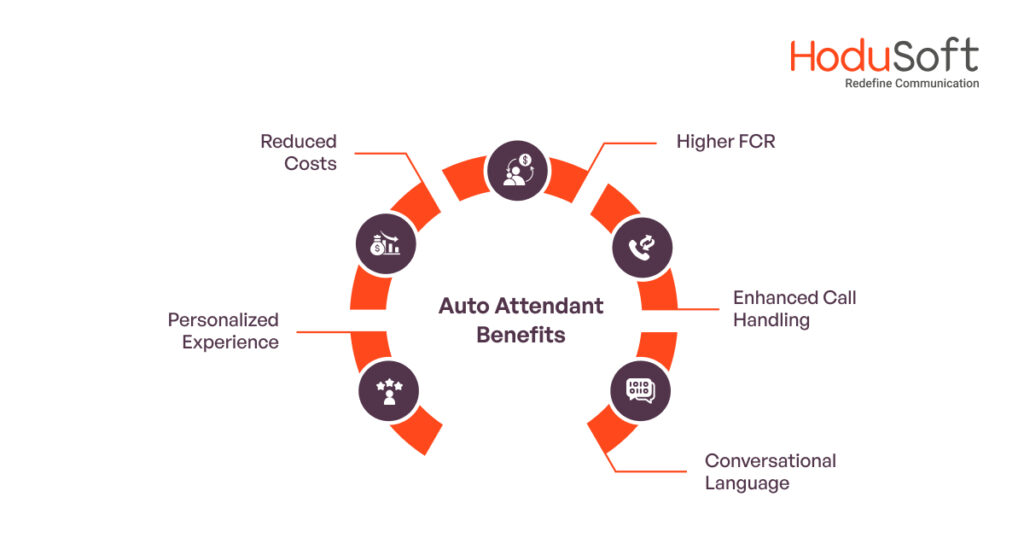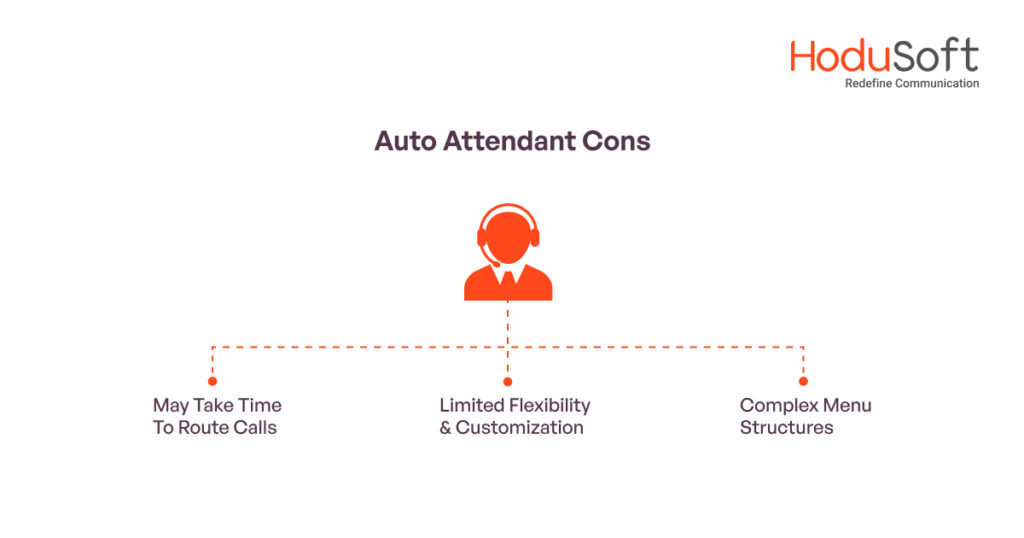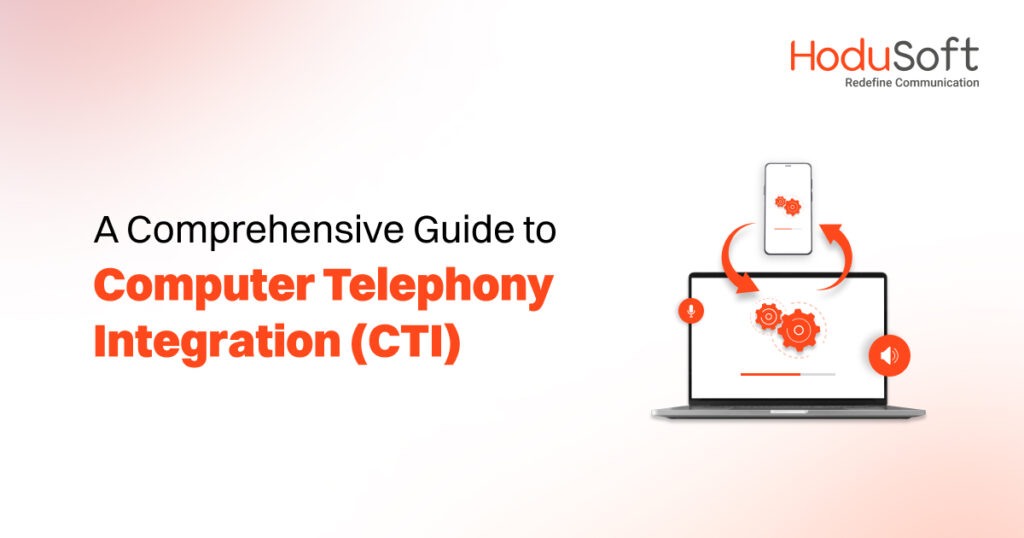Everything You Need to Know About Auto Attendant
If you have ever dialed a business phone number, you must have been greeted by an automated system, which then gives you a series of options and routes you to the right agent and department. That’s nothing but auto attendant, a technology that revolutionized the way organizations and other professional entities handle massive volumes of incoming calls.
What is an Auto Attendant?
Auto attendant, also known as Interactive Voice Responder (IVR) system is an advanced business phone system feature that automates and simplifies the incoming call process and routes the callers to the most appropriate agent or department. .
In this blog post, we will discuss everything about auto attendants starting from what they are, how they work, the pros and cons of using auto attendants, how to set up an auto attendant, and how to include scripts. Read on to know more.
Past and Present: A Brief History of Auto Attendant
Before the invention of auto attendant, callers had no choice other than to wait for their calls to be picked up by a customer support representative. No matter however they disliked keeping callers waiting, organizations were helpless.
But the innovation of entrepreneur and innovator Sanford J. Morganstein and his team marked a turning point in the history of modern-day telecommunications. In 1982, the former engineer at Bell opened his own company to focus on inventions around auto attendants. In 1989, he earned the first patent for an automated attendant.
After the mass production of auto attendants began, all types and sizes of organizations used it to route incoming calls to the right agents. In today’s era, auto attendant is the basic built-in feature that most communication systems have and its absence can be a negative point for contemporary organizations.
As per a report released by Cision PR Newswire, global auto attendant systems are expected to grow from USD 4.2 billion in 2020 to USD 6.7 billion in 2026, at a compound annual growth rate (CAGR) of 7.9 percent.
Fun fact. In today’s age, a majority of callers have an ‘average’ first impression of auto attendants. According to one research by Call Center Helper three-quarters (73 percent) of respondents scored their IVRs as a three out of five, indicating an average impression.
How Does An Auto Attendant Work?
When it comes to working mechanisms, auto attendants are fairly simple and as they say “it’s not rocket science” to understand how auto attendants work.
1. Call Arrives
This is the step when a caller dials a company’s customer care number and the auto attendant system receives the incoming call.
2. Auto Attendant Greets Caller
The auto attendant greets the caller by playing a pre-recorded audio message.
3. Provides Multiple Options
After greeting the caller, the auto attendant provides multiple options in the form of press 1 for a specific thing, press 2 for another thing, and so on.
4. Takes the Input
After the caller presses the button, the auto attendant takes the input.
5. Directs the Call
After taking the input, the auto attendant directs the call to the right department or agent.
Pros of Using Auto Attendant
Using auto attendants have many benefits and here are some of those:

1. Enhanced Call Handling
Could modern-day organizations have handled all incoming calls the same way as they do now without auto attendants? No way! Handling calls is the biggest advantage of leveraging auto attendants. When a volley of calls arrive, the auto attendant routes the calls to the most suitable agents and departments. There is absolutely no doubt that auto attendants can enhance productivity.
2. Reduced Costs
Would you be surprised to know that auto attendants can help businesses cut down operational costs? To eliminate any doubt let’s look at this study’s findings. As per a study conducted by the Aberdeen Group, auto attendant technology can reduce customer service costs by up to 30 percent. Auto attendant reduces the need for human agents to handle routine and repetitive queries, freeing them up to focus on more complex issues.
3. Personalized Experience
Customers expect personalized experiences from auto attendance. A study by Forrester found that 63 percent of customers want IVR systems to recognize their unique needs and provide personalized experiences.
4. Conversational Language
Auto attendance receives all incoming calls and engages customers and callers in conversational language. The main reason for the popularity of auto attendants is the way it enables callers to speak in their natural language instead of navigating a menu. As per a research, two out of every three customers prefer natural language IVR systems.
5. Higher FCR
Did you know that auto attendants’ FCR rate is the highest among all contact channels? As per a research by SQM Group, self-service first call resolution (FCR) rate is 74%, and those who opt for a self-service option prefer it to an IVR used to navigate callers to agents for issue resolution.
Cons of Auto Attendant
Even though auto attendants provide a lot of benefits, here are some cons.

1. May Take Time To Route Calls
Some customers may have urgent issues and they need to speak with a live agent immediately. Encountering auto attendants with long scripts could lead to dissatisfaction or frustration. That’s why organizations must keep this thing in mind and create crisper and effective scripts that could connect callers faster with the relevant departments.
2. Complex Menu Structures
If not designed and implemented properly, poorly structured menus can lead callers to select inappropriate options. Apart from that, too many options or layers of menus in auto attendant can become overly complex and difficult to navigate for callers.
3. Limited Flexibility and Customization
While auto attendants offer customization options, they may not always provide the flexibility needed to accommodate every situation or preference.
Auto Attendant Scripts – What to Record?
When creating auto attendant scripts, it’s crucial to provide clear and concise instructions to callers while also reflecting your organization’s branding and professionalism. Here are the key elements to include in auto attendant scripts:
Greetings: Start with a warm and professional greeting to welcome callers and set a positive tone for the interaction. For example: “Thank you for calling [Your Company Name].”
Identification: Clearly state the name of your company or organization to confirm that callers have reached the correct destination. For example: “You have reached [Your Company Name].”
Instructions: Provide instructions on how to navigate the menu options. Use simple language and avoid jargon to ensure callers understand their choices. For example: “For sales inquiries, press 1. For support, press 2. For billing, press 3.”
Menu Options: List each menu option sequentially and describe the corresponding department or service. Keep descriptions brief and to the point. For example: “Press 1 for Sales. Press 2 for Support. Press 3 for Billing.”
After-Hours Instructions: If applicable, provide instructions for callers reaching the auto attendant outside of regular business hours. For example: “If you are calling after hours, please leave a detailed message, and we will get back to you as soon as possible.”
Assistance Option: Include an option for callers who need immediate assistance or cannot find the information they need in the menu options. For example: “To speak with a representative, press 0 or stay on the line, and your call will be transferred to the next available agent.”
Closing: End the script with a polite farewell message and assurance that callers’ needs will be addressed promptly. For example: “Thank you for calling [Your Organization’s Name]. We appreciate your business, and a member of our team will be with you shortly.”
Best Practices for Using Auto Attendant
When it comes to using auto attendant, businesses must make sure that they implement the best practices.

1. Chart Out Entire Call Flow
A visual chart of the entire call flow can help in understanding how a majority of calls are likely to start and various individual call transfer options. This will help organizations to be prepared for all eventualities.
2. Hire Professionals to Record Audio Messages
It can be tempting to record the audio messages in-house. But the quality of voice messages won’t be good enough! Recording audio messages does require more than a nice voice and some basic recording tools. It needs the touch of professionals (voice artists and sound engineers) to give your audio messages a professional feel and experience.
3. Clear and Professional Greetings
The greetings are the most important part of the recordings. They can mean the difference between callers listening to the recorded message from start to end and leaving abruptly. That’s why make sure that the greetings in your recorded messages are clear, professional, and pleasant to hear.
4. Simple Menu Options
At the design stage it is critical to ensure that the menu options are extremely simple. When menu options are simple they make it easier for callers to navigate through and eliminate confusion. It is crucial to keep a handful of menu options for greater ease and efficiency.
5. Call Routing
After the menu options are defined, it is necessary to ensure the accuracy of the routing structure. It is essential that the calls are routed to those agents whose skills perfectly match with the callers’ requirements as well as the right departments that can address callers’ queries and issues.
6. Regular Updates
The auto attendant needs to be reviewed as well as prompts required to be updated periodically. This will ensure that your auto attendant is updated and aligned with the current needs of callers.
Industries That Can Benefit from Auto Attendants
Even though auto attendants are useful for all industries out there, some industries can benefit more from leveraging the system. Some of them are:
1. Healthcare
Medical practices, hospitals, and healthcare facilities can use auto attendants to route calls to different departments such as scheduling, billing, or patient services. Auto attendants can also provide callers with important information such as office hours, directions to the facility, and emergency contact details.
2. Telecom
Telecom companies use auto attendants to route calls to different support tiers or departments such as technical support, sales, or billing. Auto attendants can also provide callers with information about product features, troubleshooting guides, and software updates.
3. Banking and Financial
Banks, credit unions, and financial institutions can use auto attendants to route calls to different departments such as customer service, loan inquiries, or account management. Auto attendants can also provide callers with information about branch locations, ATM locations, and account services.
4. Hospitality
Hotels, resorts, and other hospitality businesses can use auto attendants to direct callers to various services such as reservations, room service, concierge assistance, or event bookings. Auto attendants can also provide information about amenities, room rates, and special promotions.
5. Real Estate
Real estate agencies and property management companies can use auto attendants to route calls to different agents or departments such as residential sales, commercial leasing, or property maintenance. Auto attendants can also provide callers with information about available listings, open houses, and rental applications.
6. Retail
Retail businesses can use auto attendants to route calls to different store locations or departments such as sales, customer service, or returns. Auto attendants can also provide callers with information about store hours, product availability, and special promotions.
7. Education
Schools, colleges, and educational institutions can use auto attendants to route calls to different departments such as admissions, registrar’s office, or academic advising. Auto attendants can also provide callers with information about enrollment procedures, course schedules, and campus events.
On the whole,
The innovation of auto attendants have revolutionized the way organizations deliver customer service. Also known as Interactive Voice Responder systems, they are among the most important features in IP-based phone systems.
Even though the auto attendant feature has been around for over four decades now, it is all the more relevant in today’s age than ever before. At a time, when most callers are willing to solve minor issues themselves and want first-call resolution from organizations, auto attendants are immensely useful.
At HoduSoft, our auto attendant feature is engineered to route all incoming calls to the right departments and agents with the required expertise and skills to resolve the issue. All our solutions, starting from contact center software to IP PBX systems, come equipped with high-quality auto attendants.` If you want to know more about our auto attendants, contact us today.



